Iron Age - Northern Europe - Fotogalerie - Sold antiquities
Archive of sold antiquities
All artefacts sold in our gallery are fully documented in our online archive and database. Being a specialist ancient art dealer, preserving also the more recent history of each and every piece sold in our shop is at our heart. That is particularly useful for artefacts that changed owners in the meantime. Information that may have been lost in the process can be easily restored from our archives. Please do not hesitate to contact us if you need further information about ancient items that have been sold in our gallery. We can help you with reconstructing the history of ownership for those items. All information about our customers will be kept confidential, of course.-
 Iron spear head worth the exhibition in a museum
Iron spear head worth the exhibition in a museumVery nice patina, smooth surface, rare degree of preservation for an iron object.
Price: on request Iron Age spearhead from Sweden
Iron Age spearhead from SwedenWell-preserved iron weapon, a find from the Swedish province of Värmland. Acquired in 1894 into the collection of the Bally-Prior Museum.
Price: on request Celtic spear head - found 1982 near Frome, Sommerset, UK
Celtic spear head - found 1982 near Frome, Sommerset, UKIron, about 2nd century BC - 1st century AD. With export permit by the Arts Council of England.
Price: on request Scythian short sword
Scythian short swordThe so-called acinaces is a typical weapon of the Scythians. Well preserved piece from the 7th to 5th centuries BC.
Price: on request Celtic spear head - found in 1970s near Radstock, UK
Celtic spear head - found in 1970s near Radstock, UKIron, about 2nd century BC - 1st century AD. With export permit by the Arts Council of England.
Price: on request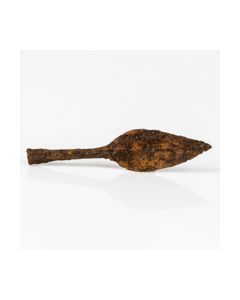 Celtic spear head - found in 1970s near Warminster, UK
Celtic spear head - found in 1970s near Warminster, UKMade of iron, about 1st century BC - 1st century AD. With export permit by the Arts Council of England.
Price: on request Large decorated violin bow fibula
Large decorated violin bow fibulaImpressive piece of jewellery because of its size and decoration. From Central Europe, made during Late Bronze Age or Early Iron Age.
Price: on request Celtic neck ring
Celtic neck ringOpen ring made of solid bronze. The torc is from Gaul or Central Europe and dates to the 4th or 3rd century BC.
Price: on request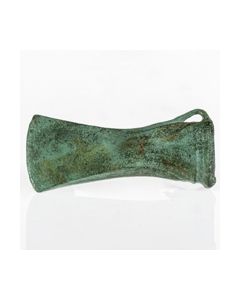 Socketed axe head from Southern Germany
Socketed axe head from Southern GermanyA typical bronze tool of the late Urnfield culture or early Hallstatt culture. It was found near Regensburg in Southern Germany by a voluntary archaeologist.
Price: on request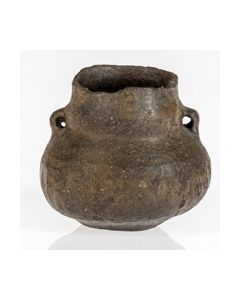 Vessel of the Urnfield culture
Vessel of the Urnfield cultureNicely preserved pottery dating to the Urnfield period, the transition between Bronze Age and Iron Age in Central Europe. Found in Southern Germany. 1200 to 800 BC.
Price: on request Celtic bracelet of the La Tène culture
Celtic bracelet of the La Tène cultureImpressive and solid bronze jewellery from the Early La Tène period, 450 to 250 BC. Found in Southern Germany.
Price: on request Melon bracelet from the Hallstatt period
Melon bracelet from the Hallstatt periodThe massive bronze bracelet was found in Mintraching, Germany. The piece is published in an archeological report. Around 600 BC.
Price: on request
 Celtic rider figurine
Celtic rider figurineMassive, very well preserved bronze with impressive details.
Price: on request Celtic fibula
Celtic fibulaRare fibula from the La Tène culture with beautiful enamel inlays. The main material is well preserved for an iron fibula.
Price: on request Cup of the Urnfield culture
Cup of the Urnfield cultureCeramic vessel dating to the transition period between Bronze Age and Iron Age in Central Europe. 1200 to 800 BC. Found in an urnfield in Austria.
Price: on request Big Cup of the Urnfield culture
Big Cup of the Urnfield cultureCeramic vessel dating to the transition period between Bronze Age and Iron Age in Central Europe. 1200 to 800 BC. Found in an urnfield in Austria.
Price: on request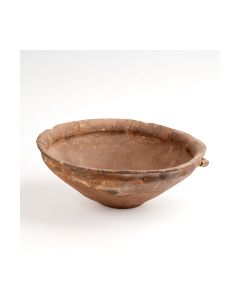 Big bowl from the Urnfield period
Big bowl from the Urnfield periodCeramic vessel dating to the transition period between Bronze Age and Iron Age in Central Europe. 1200 to 800 BC. Found in an urnfield in Lower Austria.
Price: on request Juglet from the Urnfield period
Juglet from the Urnfield periodSmall juglet dating to the transition period between Bronze Age and Iron Age in Central Europe. 1200 to 800 BC. Found in an urnfield in Lower Austria.
Price: on request Cup of the Urnfield culture
Cup of the Urnfield cultureCeramic vessel dating to the transition period between Bronze Age and Iron Age in Central Europe. 1200 to 800 BC. Found in an urnfield in Austria.
Price: on request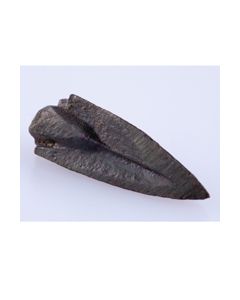 Römisch-Skythische Pfeilspize
Römisch-Skythische PfeilspizeDreiflüglige Pfeilspitze in perfekter Erhaltung. Fundort: Niedergermanien.
Price: on request Römisch-Skythische Pfeilspize
Römisch-Skythische PfeilspizeDreiflüglige Pfeilspitze in perfekter Erhaltung. Fundort: Niedergermanien.
Price: on request
 Keltischer Spinnwirtel aus Ton
Keltischer Spinnwirtel aus TonGroßer Tonwirtel, antikes Spinnzubehör, ca. 200 v. Chr., Fund aus Posen, Polen. 30mm Durchmesser.
Price: on request Keltische Glasperle
Keltische GlasperlePerle aus dunklem Glas mit wunderschön gemaserter roter Verzierung, ca. 200 v. Chr., Fund aus Posen, Polen.
Price: on request Keramikschale, Lausitzer-Kultur
Keramikschale, Lausitzer-KulturPreiswertes Schälchen aus der nordeuropäischen späten Bronzezeit bis frühen Eisenzeit. 1200 v. Chr. bis 500 v. Chr.
Price: on request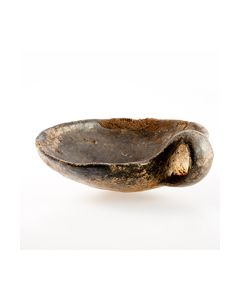 Keramikschale mit Henkel, Lausitzer-Kultur
Keramikschale mit Henkel, Lausitzer-KulturSchönes, graphitgraues Henkelgefäß aus der nordeuropäischen späten Bronzezeit bis frühen Eisenzeit. 1200 v. Chr. bis 500 v. Chr.
Price: on request Kleines bauchiges Gefäß der Lausitzer-Kultur
Kleines bauchiges Gefäß der Lausitzer-KulturKleiner bauchiger Topf mit zwei seitlichen Ösen. Dekorierte abgesetzte Schulter. Museale Erhaltung, keine Schäden oder Risse.
Price: on request Einhenkliges Gefäß der Lausitzer-Kultur
Einhenkliges Gefäß der Lausitzer-KulturBauchiges Gefäß mit abgesetzter Schulter und massivem Bandhenkel. Bräunliche Keramik mit intensivem Graphitüberzug. Exzellente Erhaltung.
Price: on request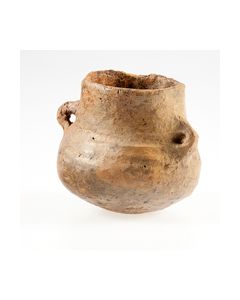 Kleines bauchiges Gefäß der Lausitzer-Kultur
Kleines bauchiges Gefäß der Lausitzer-KulturKleiner bauchiger Topf mit zwei seitlichen Ösen und abgesetzter Schulter. Vertikal verlaufende Lippe, unten zu Standfläche abgeflacht.
Price: on request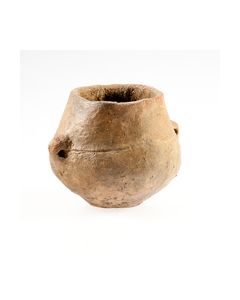 Kleines bauchiges Gefäß der Lausitzer-Kultur
Kleines bauchiges Gefäß der Lausitzer-KulturKleiner bauchiger Topf mit zwei seitlichen Ösen. Durch Rille abgesetzte Schulter. Möglicherweise Votivgabe oder Grabbeigabe für Kinder.
Price: on request Keltischer Spinnwirtel
Keltischer SpinnwirtelSpinnwirtel aus Ton. Bikonische Form, Durchmesser 28 mm. Aus keltischer Zeit.
Price: on request Gesichtsurne mit Deckel, Lausitzer Kultur
Gesichtsurne mit Deckel, Lausitzer KulturÄußerst seltener und beliebter Gefäßtyp der Lausitzer Kultur. Etwa 1300 bis 500 v. Chr., Übergang zwischen Bronze- und Eisenzeit in Europa. Komplett erhalten, inklusive Deckel.
Price: on request Flache Schale oder Präsentierteller, Lausitzer-Kultur
Flache Schale oder Präsentierteller, Lausitzer-KulturUnterseite durch keilförmige Eindrücke und längliche Abschabungen dekoriert. Lippe mit Kerb- und Noppendekor.
Price: on request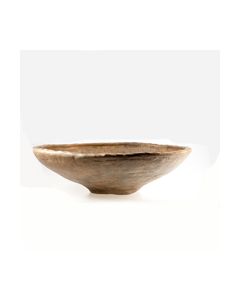 Sehr große Schale oder Präsentierteller, Lausitzer-Kultur
Sehr große Schale oder Präsentierteller, Lausitzer-KulturDer breite, flache Lippenrand mit Kerbdekor, das an die Struktur eines dicken Seils erinnert. Lippe leicht nach Innen überstehend.
Price: on request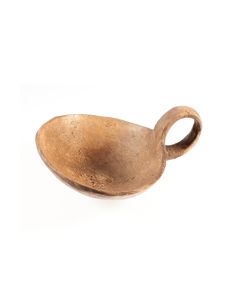 Große flache Trinkschale, Lausitzer-Kultur
Große flache Trinkschale, Lausitzer-KulturMit Henkel. Körper mit Omphalos, unten am Henkelansatz zwei weitere sphärische Eintiefungen zu jeder Seite. Museales Stück.
Price: on request

